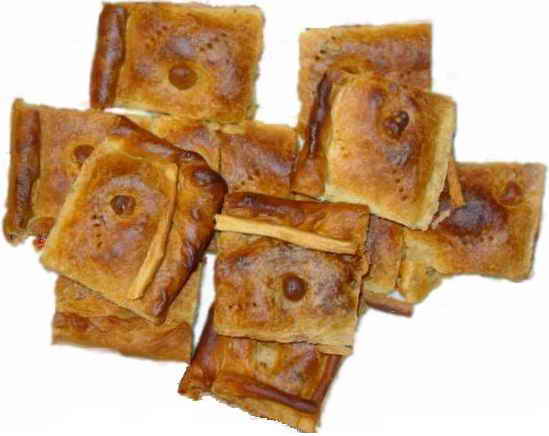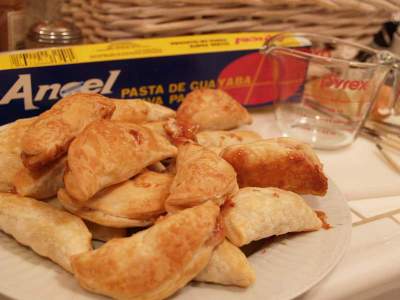The Cornish Pasty |
So far, we have not been able to locate a source of images for Spanish pasties, although it is widely stated that the empanada originated in Galicia, Spain. Pasty-shaped empanadas are shown for many other countries on this web site and "Spanish empanadas" are shown widely on sites in other countries, and, franchised in the USA - see Mr Empanada.com, with a history of the empanada HERE.
We have found a few Spanish/Galician images that show the empanada as a large pastry-covered pie, similar to a pasty pie, that gets cut into individual servings .....

Source: http://es.wikipedia.org/wiki/Empanada_gallega
- the Spanish version of Wikipedia
However, some of the preparation methods, some of which are presented below, describe how to make them in a half-round (like a regular Cornish pasty) or triangular shape
From: About.com - Latin Caribbean food
"Empanada comes from the Spanish verb empanar, which means to wrap in bread. An empanada is made by folding a disc of thinly rolled dough over a filling into a semicircle and then sealing the edge."
From the same source:
"Cubans fill their empanadas with seasoned ground beef or chicken and then fry them. Pastelitos are similar, but are made with lighter pastry dough and can be either baked or fried."
Pastelitos, muchachos !
Retrieved from Wikipedia - Empanada
"In Spain, Portugal, the Caribbean, Latin America, and the Philippines, an empanada (Portuguese empada- a different dish) is essentially a stuffed pastry. The name comes from the Spanish verb empanar, meaning to wrap or coat in bread. Usually the empanada is made by folding a thin circular-shaped dough patty over the stuffing, creating its typical semicircular shape. Empanadas are also known by a wide variety of regional names (see the entries for the individual countries below).
It is likely that the empanadas in the Americas were originally from Galicia, Spain, where an empanada is prepared similar to a pie that is cut in pieces, making it a portable and hearty meal for working people. The Galician empanada is usually prepared with cod fish or chicken. Due to the large number of Galician immigrants in Latin America, the empanada gallega has also become very popular in that region. The idea of an empanada may originate from the Moors, who occupied Spain for 800 years.[citation needed] Middle Eastern cuisine to this day has similar foods, like simbusak (a fried, chickpea filled "empanada") from Iraq."
Source: Lighten up! - Empanada - Gallega (Galician Pork & Pepper Pie)
"Working with 1 portion of dough at a time (cover remaining dough to keep from drying), roll each portion into a 13-inch circle on a floured surface. ..... Spoon filling onto dough using a slotted spoon, leaving a 1-inch border around the edge. Place remaining portion of dough over filling. Pinch edges to seal. Cut several slits in top of dough to allow steam to escape. Brush with egg. Bake ....."
That describes the preparation of a pasty .....
Also ..... Spanishfood.about.com - spanish regional cuisines - galicia says:
"Galicia is located in the extreme northwestern corner of Spain. Galicia's west coast is on the Atlantic Ocean while the north coast is on the Cantabric Sea. It is a cold, wet climate, with rugged terrain and over 700 miles of rocky coastlines and historically one of the poorest areas of Spain. Small family farms of an acre or two exist growing vegetables, however many families live from fisherman's catches. The people of Galicia are descendents of Celtic people, whose myths, legends and belief in the mystic are strong even today. ...............................
Learn how to make delicious Empanadas Gallegas with either meat or tuna filling with our step-by-step recipe."
..... and following the Empanadas Gallegas link ...... we find ....
"Empanadas Gallegas or Galician Turnovers are one of the most popular dishes from Galicia. Empanadas in Galicia are traditionally large round or square turnovers that are cut into pieces to serve. The version that we will make here are smaller individual turnovers, commonly referred to as empanadillas. The dough recipe makes enough dough to make one large empanada or several dozen empanadillas. For simplicity's sake, we will refer to them as empanadas in this step-by-step."
..... and one of the steps in assembling the empanadas/empanadillas .....
"To make triangular-shaped empanadas - Cut the dough into 4" squares, scoop a heaping tablespoon of filling into each square and brush the egg white on to 2 edges of the dough. Fold over and press with fingers to seal.
To make half-round empanadas - Using a large-mouth jar or a large 4" diameter cookie cutter, cut out circles in the dough, scoop a heaping tablespoon of filling into each circle and brush the egg white around half of the circle.
Fold over and press with fingers to seal.
An alternative to sealing with your fingers, you can seal by pressing the tines of a fork along the edges of the dough. Carefully place each empanada on a cookie sheet to bake."

Acknowledgement: My thanks to Marta Darby for permission to use the pastelitos photo.
So there we have it, empanadas and pastelitos bear some resemblances to the Cornish pasty .....
